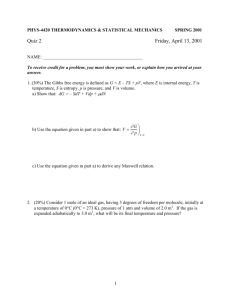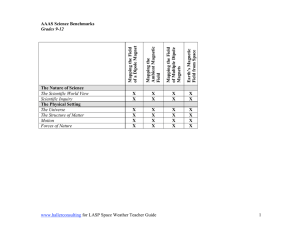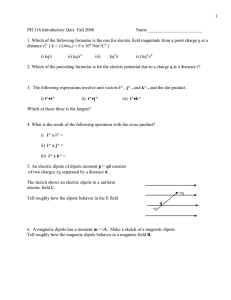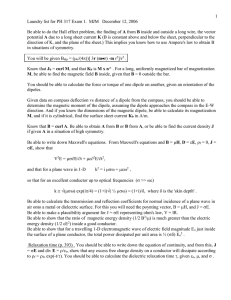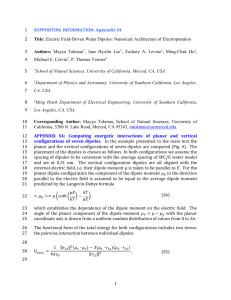Lesson Summary Teaching Time Materials for Teacher
advertisement
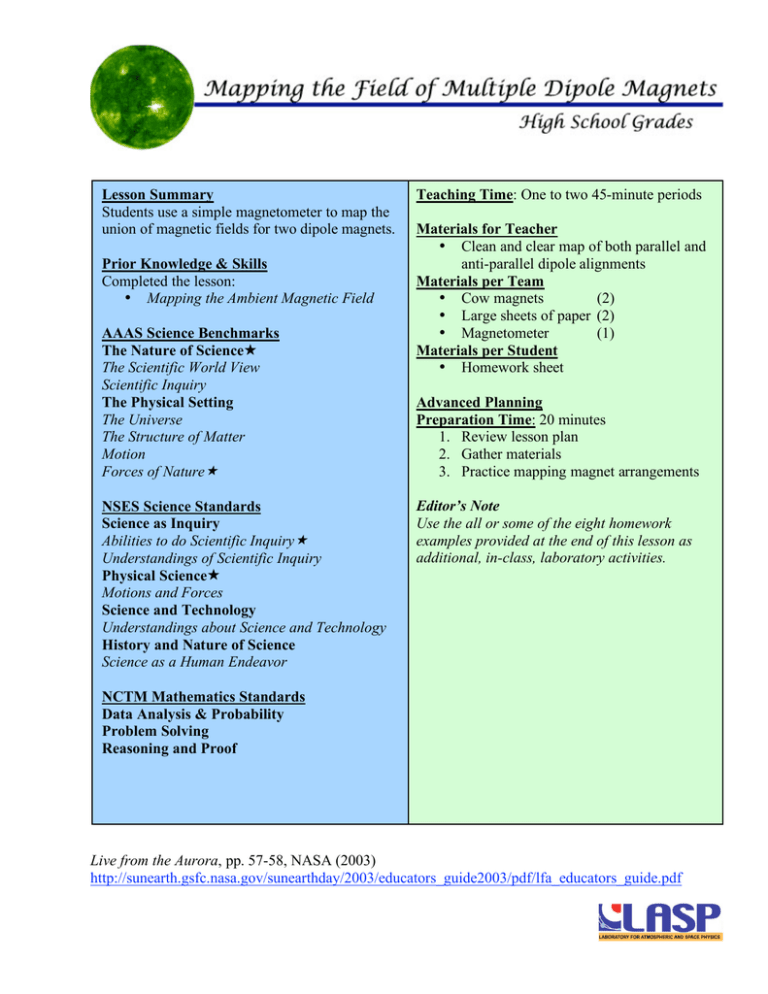
Lesson Summary
Students use a simple magnetometer to map the
union of magnetic fields for two dipole magnets.
Prior Knowledge & Skills
Completed the lesson:
• Mapping the Ambient Magnetic Field
AAAS Science Benchmarks
The Nature of Science
The Scientific World View
Scientific Inquiry
The Physical Setting
The Universe
The Structure of Matter
Motion
Forces of Nature
NSES Science Standards
Science as Inquiry
Abilities to do Scientific Inquiry
Understandings of Scientific Inquiry
Physical Science
Motions and Forces
Science and Technology
Understandings about Science and Technology
History and Nature of Science
Science as a Human Endeavor
Teaching Time: One to two 45-minute periods
Materials for Teacher
• Clean and clear map of both parallel and
anti-parallel dipole alignments
Materials per Team
• Cow magnets
(2)
• Large sheets of paper (2)
• Magnetometer
(1)
Materials per Student
• Homework sheet
Advanced Planning
Preparation Time: 20 minutes
1. Review lesson plan
2. Gather materials
3. Practice mapping magnet arrangements
Editor’s Note
Use the all or some of the eight homework
examples provided at the end of this lesson as
additional, in-class, laboratory activities.
NCTM Mathematics Standards
Data Analysis & Probability
Problem Solving
Reasoning and Proof
Live from the Aurora, pp. 57-58, NASA (2003)
http://sunearth.gsfc.nasa.gov/sunearthday/2003/educators_guide2003/pdf/lfa_educators_guide.pdf
55
Background for Activities 3 and 4
The students have learned about simple mapping
of magnetic dipole fields. In Activity 2, the students saw
that along with the dipole field, there was an underlying ambient field, produced largely by the Earth and
partially by minor sources within the lab area. In homework, the students have looked at how animals sense
the magnetic fields around them and exploit the information in an effort to survive.
In these next two activities, students will look at the
union of multiple magnetic fields. Activity 3 is to explicitly map the combined field of two aligned dipoles and
two anti-aligned dipoles. For homework, students will
predict what happens for other arrangements of two
dipoles. In Activity 4, students will check their predictions and learn about the Sun-Earth magnetic interactions. Homework will be to look at the magnetic field
mixing in the solar system between the solar wind and
Earth. An extension activity is provided which looks at
the solar wind interaction with Jupiter and the Jupiter-Io
magnetic interaction leading to 20 MHz radio signals
received by radio astronomers on Earth.
Activity 3
Mapping the Field of Multiple Dipoles
Teacher Instructions
Goal: Students will map fields of two dipoles in the
same map. Students will understand the field representation does not allow field lines to cross. Students will be
able to predict the field map resulting from increasingly
complex arrangements of 2 dipole magnets.
Materials per student:
•
2 cow magnets per student
•
2 large sheets of paper
•
Student magnetometer
•
Pencil/pen
Teacher Preparation:
•
Assemble materials
•
Assemble homework sheets
•
Check Web sites for inactive links
•
Prepare a clean and clear map of both parallel
and anti-parallel dipole alignments. This will be
shown to the students at the end of class if discussion has not proceeded to the point of consensus
agreement of what the student-made maps
should look like.
Vocabulary
•
Geomagnetic field
•
Dynamo
1.
Discuss homework with students.
2.
Assign Mapping of the Field of Multiple Dipoles. In
this activity, students will be asked if they can tell
when the magnetic influence or field at the location
of the magnetometer is nonexistent. They cannot. It
is an important part of understanding the limits of
the magnetometer and analyzing the data collected.
In this mapping exercise, there may be several
locations where the direction of the magnetic field is
very sensitive to the position of the magnetometer. The
limit of spatial resolution by a magnetometer is probably on the order of a centimeter. Students may not recognize until the discussion that they have encountered
a limit of the equipment. This is a good opportunity to
underscore the limits on the precision of the procedure
and its effect on drawing conclusions, and finally the
need to extrapolate through logic to make hypotheses
and predictions for the areas where instrumental resolution does not allow observations.
3.
Discuss activity and results as a class group.
•
Did removing the ambient field lead to significant changes in the field maps?
{Suggested response: Especially in regions
between the anti-aligned dipoles, the removal is
problematic as we are not sure of the relative
strengths of the dipoles, and how the strength
decreases with distance away from the dipole. We
can make two guiding assumptions: (a) far from
the dipoles, the field is completely background or
ambient; (b) somewhere between two anti-aligned
dipoles occurs a point where the total field strength
is again only due to the background as the two
dipoles contribute equal and opposite field
•••MAGNETISM
56
strengths. By logic, this point should be on a plane
intersecting the line joining the dipoles. If we can
find and identify these two regions, we can begin
to make intelligent guesses about the relative
strength of field contributions from each dipole at
any point in the mapping area. While this is a difficult and imprecise process, it is also one that
yields a reasonably accurate result.}
•
•
If two sources of magnetic field had equal
strengths and opposite alignments at some
location in space, and you placed a magnetometer at that location, what observation
about the local magnetic field would you
report? Can you distinguish between a location
with no magnetic field and a location where
all the magnetic fields exactly cancelled each
other? {Suggested response: At this time, no, the
students cannot distinguish between these situations. The magnetometer magnet will have a natural
position that is related to the torsional strength of the
string, the details of the mass distribution of the
hanging magnet structure, and the details of the
attachment of the magnet to the string.}
Show how the magnetic fields of separate
dipoles add to produce the 2-dipole fields
you have mapped. That is, show through
some means of adding directional indicators
from the single dipole maps made two days
ago how the 2-dipole (aligned and antialigned) maps are foreseeable results.
{Suggested response: By overlaying the single
dipole maps, offset by the distance between the
dipoles in the 2-dipole maps, and making an
approximate addition of the nearby direction data
•••••••
on each layer, one can generate a procedure for
predicting how a 2-dipole map should appear.
Some simple rules should result, as follows.
For Parallel Alignment
Dipole 1 produces Field 1 while Dipole 2 produces
Field 2 at the indicated point. The result of adding F1
and F2 is Sum, the actual observed orientation of the
students’ magnetometer. The arrow overlaying the
smaller dipoles 1 and 2 indicates how aligned dipoles
mimic a single larger dipole.
For the Anti-Parallel Alignment
Notice in this example two locations are exhibited.
Dipole 1 produces measured fields F1 and F­a, at the
respective points, while Dipole 2 produces measured
fields F2 and F­b at the respective points. The measured
fields F1 and F2 add up to a measurement called Sum,
which points between the source magnets. The measured fields F­a and F­b are in opposite directions. If they
are of equal magnitude, they will combine to create a
zero magnitude field at that point.
We note that zero magnitude magnetic field is a
very hard spot to find, however, as the magnetometer
does not distinguish a zero strength field, and a slight
movement of the magnetometer lets it line up on the
closer of the dipoles. That is, at this location, it should
seem as if the magnetometer cannot “make up its
mind” about what direction to point.
When you have a completed map of the antialigned orientation, you will have mapped a
Quadrapole field.
3.
Assign Magnetic Field Mapping Exercise
57
Student Activity 3
Mapping the Field of Multiple Dipoles
Goal: If two dipole magnets are positioned near
each other, what will the map of the field look like?
How does the orientation of the magnets affect the
shape of the field? How can you predict the field map
resulting from increasingly complex arrangements of 2
dipole magnets?
Background: The minimum source of magnetic
field is the dipole. That is, there are no individual poles
of magnetic “charge.” One must get a South attached
to every North. The magnetic field encountered in life
and industry is rarely just a single dipole field. The
fields seen are combinations of many dipoles. This is
analogous to the field produced by a large amount of
positive charge: The electrostatic field seen is a combination or “sum” of all the single charge fields. The
shape of the field is symptomatic of the arrangement of
the charges forming it.
Basic task:
6.
The dark part of the oval is the opposite pole of the
lighter part. The poles are not close enough to cause
one magnet to move away from the other one.
7.
Using your knowledge of the ambient field, can
you correct the maps made in (5) and (6) so that
they show just the field of the dipole arrangements? Estimate what the corrected field would
look like.
8.
Draw smooth curves showing the shape of the
combined dipole magnetic fields and add arrows
to indicate field direction.
9.
Title the maps with date, time, group names, and
information about the orientation of the map in the
room, the alignment of the dipoles, and whether
the ambient field has been removed.
In groups of two, map the field of two dipoles in a
given arrangement and remove the effect of the background field to get a more accurate map.
Lab supplies:
Each student group will need the following materials:
•
3 large sheets of paper
•
2 cow magnets
•
1 magnetometer
•
Pencil and tape
Procedure for mapping two dipoles
1.
Determine and label the ends of the cow magnets
as N/S.
2.
Mark off a 10-cm grid on all sheets.
3.
Identify the specific location where you will be
making your maps. Mark the edges carefully with
tape.
4.
Map background field at this location.
5.
Map the combined magnetic field of the pair of
parallel, aligned dipoles on the same sheet of
paper as used in (4).
Repeat (4) and (5) on a new sheet of paper with
the poles oppositely aligned, as shown in the diagram below.
Questions to be answered in your lab notebook
before class discussion.
a. Write down the procedure you used to insure that
the dipole field maps were made in the same
location as the ambient field maps.
b.
Write down the procedure you used to remove the
effect of the ambient field map from the dipole
fields. Write down the factors that make you confident in your results and those that make you less
confident.
•••MAGNETISM
58
c.
Make a chart of the similarities and differences
between the maps. Look for big things and look
for details.
d.
Present your work to the teacher for checking.
Student Activity 3
Magnetic Field Mapping Exercise
You have mapped the magnetic field of aligned
and anti-aligned dipoles. Using what you have
•••••••
observed and the understanding your class came to in
the discussion, please predict what a mapping exercise would show for the following configurations of
dipole magnets. Note: the ovals are the magnets and
the white-to-gray gradient denotes the magnetic poles.
All magnets are the same strength. Draw a sufficiently
large set of lines to show the field map at all points.
